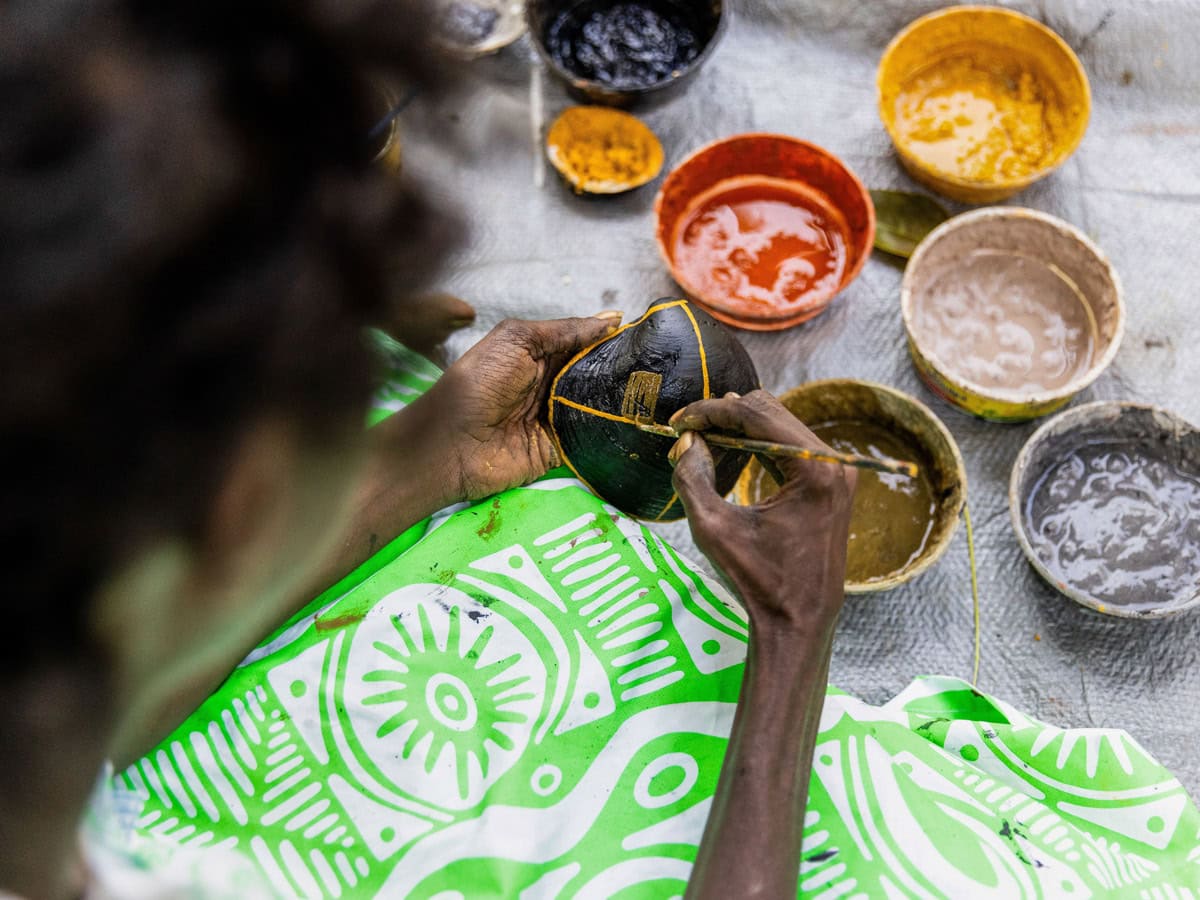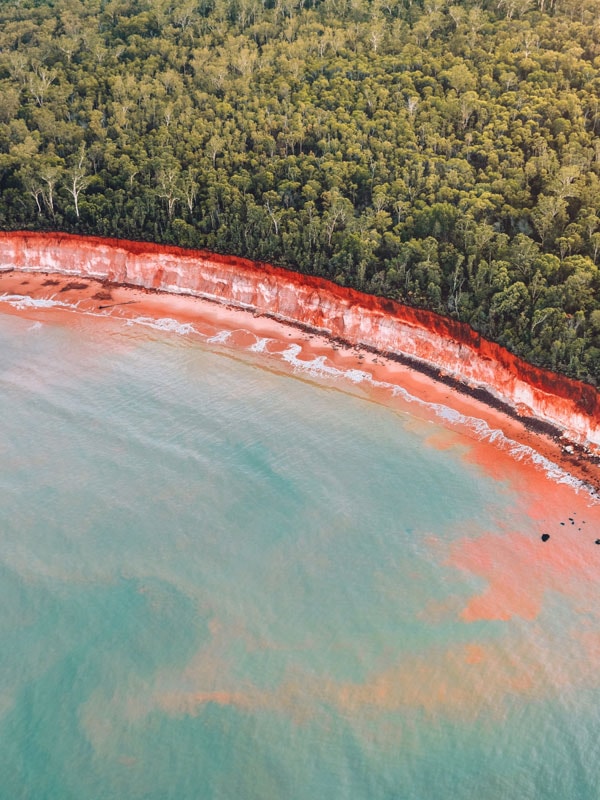08 May 2024
![]() 9 mins Read
9 mins Read

This article is part of our 100 Australian Wonders series. Throughout the series, we explore our nation’s wonders across culture, nature, food, islands and many more. We hope it inspires your own exploration of Australia’s many wonders.
Travelling with: Elizabeth Whitehead
Art runs through the heart of the Tiwi Islands, just like the Apsley Strait that cleaves the verdant landmass in two. The strength of culture here is especially apparent when visiting one of the many art centres scattered across the islands.

The incredible beauty of Rainbow Beach from above. (Image: Tourism NT)
At an art centre (such as Jilamara Aboriginal Arts and Crafts), you’ll see artists carving, painting and creating works in the distinctive Tiwi style, characterised by the mesmerising technique of crosshatched brushstrokes and geometric shapes.

There are many art centres scattered across Tiwi Islands. (Image: Tourism NT/Helen Orr)
You’ll find walls decorated with art, bark serving as the canvas and natural ochre pigment as the paint. Sculptures are elaborately carved from ironwood, often depicting birds, as are tutuni (funerary totem poles) that adorn burial sites on the islands. Art is a vessel to share Tiwi Creation stories, wisdom and knowledge; an insightful window into the culture of this fascinating place located little more than a footy’s kick north of Darwin.

See artists at work during a cultural tour. (Image: Tourism NT)
Travelling with: Steve Madgwick
The only way to truly grasp the significance of Garma is to sit in the red dirt and chat with its Traditional Owners. The annual four-day Indigenous cultural festival is held on the wildly stunning and thriving Yolngu homelands and includes the open-air Gapan Gallery.

The Gapan Gallery set amid a grove of gums.
What basically began as a community barbecue for Arnhem Land locals in 1999 has blossomed into a national celebration of 50,000-year-old song, story and dance. Its forum, attended by Australia’s most powerful decision-makers, is a dynamic lesson on the strengths and issues of Aboriginal Australia.
As Garma ambassador and award-winning actor Jack Thompson said: “Every Australian should come; every Australian child should have Garma as part of their curriculum.”

Gumatj man Cedric Marika performing at Garma Festival.
Travelling with: Megan Arkinstall
For more than half a century, the Tamworth Country Music Festival has been the national stage for country music, culture and heritage. Big-name artists such as Lee Kernaghan, Troy Cassar-Daley and Kasey Chambers are regulars at the iconic event, with performances across outdoor stages and pubs, a street parade, busking competitions and the Golden Guitar Awards. Giddy up for the 2025 fest, which runs for 10 days from 17-26 January.

Circle Tamworth Country Music Festival on your calendar.
Travelling with: Jo Stewart
You’ll find a compact celebration of Australian music in a quiet corner of the Arts Centre Melbourne. Home to a well-curated collection of instruments, clothing, posters, props and other ephemera, it’s free to enter this vault dedicated to the Aussie entertainers who have made their mark on the world.

Amplify your love of music at the Australian Music Vault. (Image: Arts Centre Melbourne)
From Nick Cave’s notebook to outfits worn by Kylie Minogue and a battered, old suitcase (complete with faded Ansett tags) that once belonged to multi-instrumentalist Warren Ellis, this nostalgic walk down memory lane will pull at your heartstrings whether you’re a fan of grunge, pop, punk or pub rock.

Make some noise for the exhibition dedicated to Mushroom Records. (Image: Georgia Roberts)
Travelling with: Lara Picone
With Asia more easily accessible than the next Australian capital city, it hardly raises an eyebrow that Darwin’s food culture is fringed with the culinary vibrancy of the south-east. Sure, you can taste it about town on any given day. But the seasonal Mindil Beach Sunset Markets is the place to deep-dive into the adopted flavours of our northernmost city.

Mindil Beach Sunset Markets serves up tastes from Turkey to Timor. (Image: Tourism NT/Sean Scott)
Mindil is more than a market – it’s an iconic attraction. Watch as the tropical sun is slowly swallowed by the shimmering sea and the soft backbeat of bongos mingles with the warm night air thick with aromatic smoke.

Watch the sun sink into the ocean from Mindil Beach. (Image: Tourism NT/Sean Scott)
The whole thing wields the power to entrance and the probability of purchasing happy pants or a rainbow crocheted hat becomes dangerously high.

There are over 200 stalls to browse. (Image: Tourism NT/Sean Scott)
Travelling with: Steve Madgwick
You’ll find the Mad Max 2 Museum, a temple of pure quirk and obsession, inspired by one of Ozploitation’s seminal films in the wee outpost of Silverton, north-west of Broken Hill. This ode to the ‘wasteland’ is the brainchild of Adrian and Linda Bennett, superfans who moved from the UK in 2010, driven by a fixation with Mad Max 2 (circa 1981).

Mad Max 2 Museum features life-sized characters as well as original and replica vehicles from the film. (Image: Steve Madgwick)
George Miller’s post-apocalyptic movie was filmed nearby at epic outback locations such as Mundi Mundi Lookout. The intentionally ramshackle corrugated shack is stuffed with props (including the leather suit worn by Mel Gibson), black-and-white production stills and a stable of trademark beasty cars from the franchise.
The pilgrims will flow on, thanks to Mad Max: Fury Road (2015) and this year’s release of spin-off Furiosa: A Mad Max Saga.

Check into the Silverton Hotel. (Image: Destination NSW)
Travelling with: Carla Grossetti
Indigenous art fairs around Australia are designed to foster and nurture Aboriginal and Torres Strait Islander art, design and culture.

Meet Greg Joseph, of Burrunju Art Gallery at the National Indigenous Art Fair. (Image: Destination NSW)
See First Nations culture and creativity take centre stage at the Darwin Aboriginal Art Fair – the largest of its kind – from 9-11 August. Sydney’s National Indigenous Art Fair will bring a stroke of colour to The Rocks 29-30 June and the annual Cairns Indigenous Art Fair will take place 24-28 July.

A woven artwork by Yulki Nunggumajbarr on show at Darwin Aboriginal Art Fair. (Image: Tamati Smith)
Expect the carefully curated programs to include everything from artist talks to hip-hop performances, weaving workshops, masterclasses and more. Visitors to the various Indigenous art fairs will also be given the opportunity to purchase one-of-a-kind ethically sourced artworks.

Purchase art from Carol Puruntatameri, of Munupi Arts & Crafts Association. (Image: Ben Searcy)
Travelling with: Carla Grossetti
Sporting fans descend on the Victorian capital each year to watch the highest-ranking players of the game thwack the ball back and forth over the net.
But it’s not just about watching the sport’s superstars battle it out in centre court for the title of the Australian Open. There’s the Champagne. The fashion. The people-watching. The unlikely wild cards. The off-court culture. The ball boys kneeling by the net. And of course, the tension felt in the crowd as a hard-fought game reaches break point.
Expect style queen Zendaya’s new steamy rom-com film Challengers (about a prodigy turned pro) to lure even more fans to the annual event.

The Australian Open is just the ticket for tennis fans. (Image: Morgan Hancock)
Travelling with: Lara Picone
The Gunditjmara people of south-west Victoria could tell you a thing or two, not least about how to catch a kooyang (eel). With a shared cultural knowledge that stretches back for at least 30,000 years (but likely far more), their Country is home to the Budj Bim Cultural Landscape, listed by UNESCO as a World Heritage site that encompasses the areas of the Budj Bim volcano, Tae Rak (Lake Condah) and Tyrendarra and is recognised as one of the largest and oldest aquaculture systems in the world.
To take a misty morning walk through the intricate dams and channels that were devised to trap eels, back to a time when megafauna roamed the continent, is a mind-blowing rewind back to the Pleistocene. Astonishingly, despite centuries of being stomped by cattle, the restored site remains as proof of humanity’s extraordinary continuity.

Take an Indigenous-led cultural tour of Budj Bim Cultural Landscape.
Travelling with: Steve Madgwick
Subtropical pine trees, obstinate cows and wild roosters. Elderly folks dawdling along serpentine B-roads in micro-cars. Deep-green paddocks next to sinister Georgian-era convict ruins. These images might paint the picture of Norfolk Island if you’ve never visited before. But they barely peel back a single layer of the cultural complexities of this 35-square-kilometre Australian external territory (1412 kilometres east of Evans Head).

Norfolk Island is so much more than it’s breathtaking scenery. (Image: Norfolk Island Tourism)
A place profoundly entwined and defined by a population descending from the English and Tahitian mutineers of the Bounty, Fletcher Christian’s kin, who resettled on Norfolk when they outgrew the Pitcairn Islands. And from Heidi Bigg, who runs The Golden Orb Cafe, to the restaurateurs behind The Homestead, Kurt and Jill Menghetti, and to glass artist Jai Adams, whose work is on display at Norfolk Island Botanic Garden, to know the essence, quirks and jewels of 21st-century Norfolk Island is to know its people.

It’s the people of Norfolk Island who reveal the essence of what makes this place special. (Image: Norfolk Island Tourism)
LEAVE YOUR COMMENT